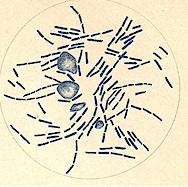|
Welcome
Page
Anthrax
Home Page
1887
Outbreak
Other
Missouri Cases
|

|
- Anthrax (also known
as wool sorters disease, malignant pustules, milzbrand,
charbon, splenic fever) is one of the oldest and most
destructive diseases of livestock known.
- While it is chiefly
limited to cattle and sheep, it may be transmitted to
goats, horses, cats, and certain kinds of game.
- Anthrax is
caused by rod shaped bacteria (bacilli). This bacteria
has the ability to form spores.
|

|
Bacilli of
anthrax magnified 500 times. This is a 1916 plate
showing bacilli obtained from the blood of a cow
that had died of anthrax in Mississippi. The
bacilli are stained blue. The large round objects
are blood cells.
USDA,
1916
|
- The spores of anthrax
are extremely resistant to temperature, sunlight, drying
and chemical disinfectants. They can live for years in
the environment; anthrax bacteria have been reported to
survive for 60 years in a laboratory
setting.
- Anthrax can be spread
through the respiratory tract. Dried spores may be
inhaled and reach the general circulation by way of the
capillaries of the lungs. Human beings following certain
occupations, as wool sorting, mattress making, etc.,
obtain infection in this way more often than do the lower
animals.
- As early as
1912 it was known that Anthrax was spread through the
respiratory tract. Dried spores may be inhaled and reach
the general circulation by way of the capillaries of the
lungs. Human beings following certain occupations, as
wool sorting, mattress making, etc., obtain infection in
this way more often than do the lower animals.
- Anthrax may
also be contracted through the skin. When infection is
introduced through the skin, there results the condition
known as external anthrax, carbuncular disease,
inoculation anthrax, or malignant pustule.
- The digestive tract
also provides a mode of infection. The internal, or
intestinal, form of anthrax is generally produced through
taking the virus in contaminated food or water
References
- Reynolds, M.H.
Veterinary Studies for Agriculture Students. New York:
The Macmillan Company. 1912: 152.
- Atkinson, et al.
Special Report on Diseases of Cattle. Washington:
Government Printing Office, 1916: 447.
|
![]() This
page was designed by Lyndon Irwin and researched by Josh
Worthington.
This
page was designed by Lyndon Irwin and researched by Josh
Worthington.![]() For
more information, contact Lyndon
N. Irwin
For
more information, contact Lyndon
N. Irwin